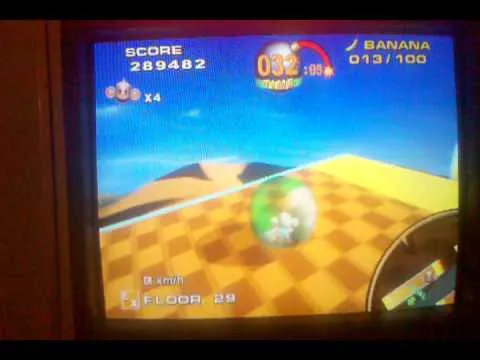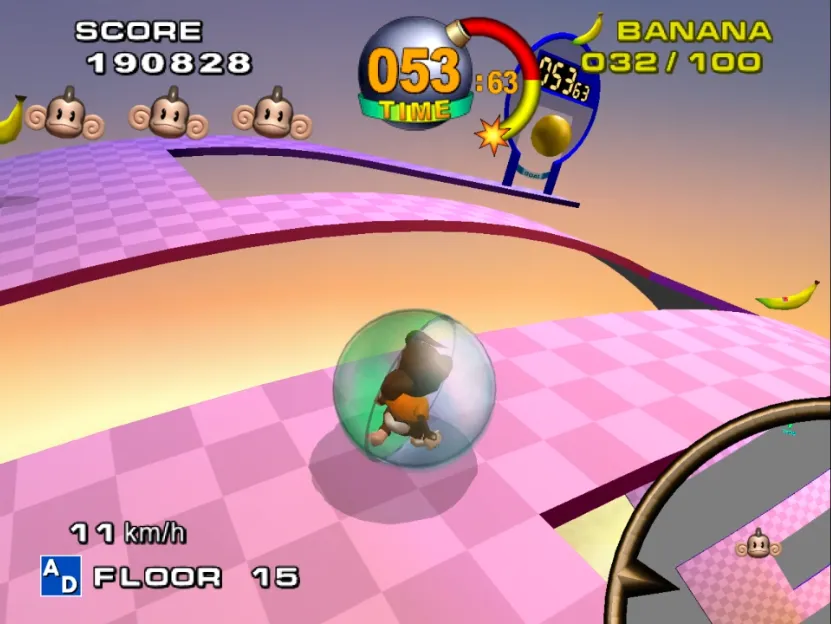

You might have heard of Super Monkey Ball, which has seen a rollercoaster of ups and downs on its history, with a very strong start through the first two Gamecube titles (and the Deluxe port merging both games for Xbox and PS2), but then having inconsistent or mixed results, as some games like Super Monkey Ball Jr., Touch and Roll and 3D kept the same simple gameplay but everything varied depending of the controls and level design (and Adventure which had the same gameplay as a side mode but had an adventure mode too...which didn't age well), while others like Banana Blitz, Step and Roll and Banana Splitz had a different focus on a control gimmick as well as adding a Jump button. While Banana Mania, the latest remake of the first two games, had a couple of tidbits, it overall has been the highest on the franchise after so long, as it nailed the gameplay perfectly with a modern coat of paint.
...but what are we talking about today then? Well, Monkey Ball is the actual first game in the franchise ever, released on the Dreamcast-based NAOMI board for Arcade, and while this game was pitched to be ported to Dreamcast with a visible facelift, this improved version ended up getting moved instead into the Gamecube, as it would be known as Super Monkey Ball. With that said, Monkey Ball on the Arcade is virtually the same main game as the first SMB, with differences being on the presentation, and the absence of a certain set of extremely hard levels that I will get to later on.
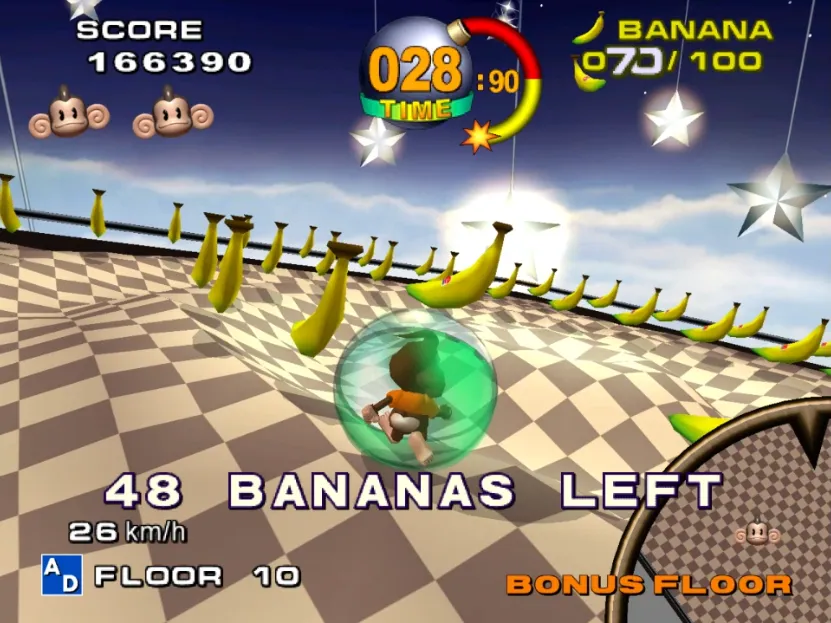
The premise is extremely simple: Roll using the analog stick to the end of the level before the time runs out, though in the original arcade cabinet you actually had to play with a banana-shaped joystick (as I emulated the game, I instead used a Gamecube controller, which I have to add that is extremely fitting to play games like these). While the Gamecube game had an assorted amount of detailed backgrounds at several places for a certain amount of worlds, this version starts with a very simple sky background and checkered floor, and while some stages have backgrounds like being at a desert or in space, these still are pretty simple while once again using checkered floor for the levels.
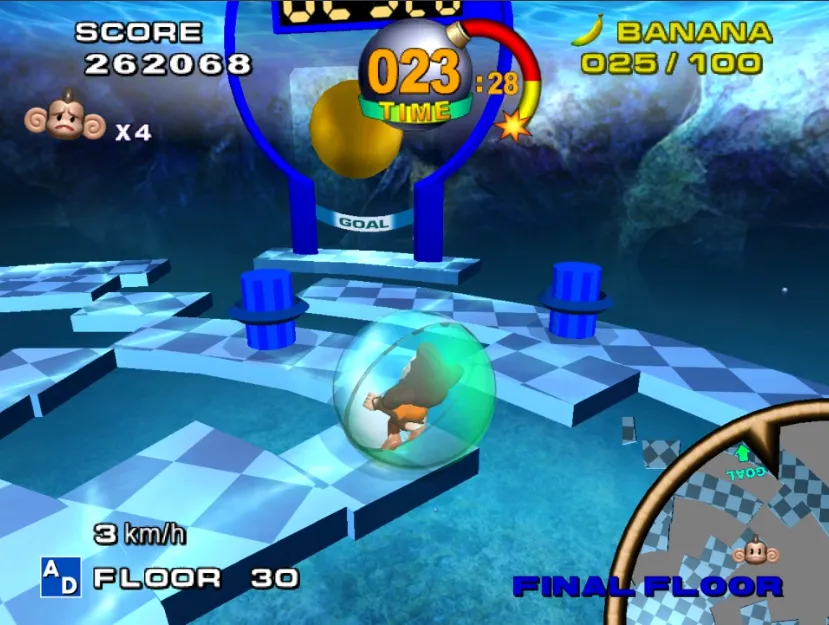
You have three sets of levels: Beginner (10 levels), Advanced (30 levels) and Expert (50 levels), and in some levels, you could find secret Green or Red goals instead of the usual Blue goal that would let you skip some levels ahead. The Beginner levels are exactly as easy as they sound and are perfect for anyone trying the game for the first time, be it trying to get all bananas or aiming for the goal as fast as they can, and essentially is a tutorial campaign before taking off the training wheels at Advanced. Clearing the whole thing without falling off once unlocks three Extra levels, which also are pretty simple to clear if you got used to the controls.
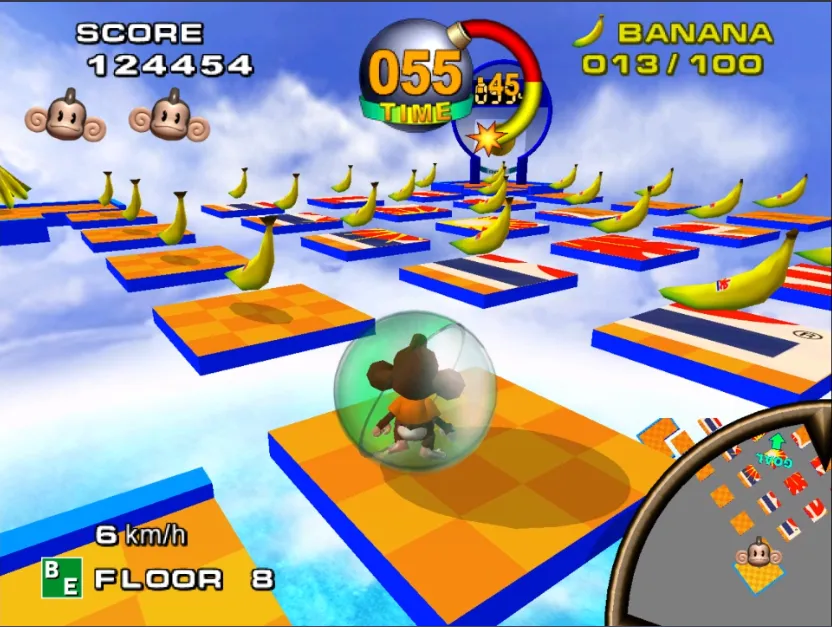
That said, the Advanced levels ask for a much higher level of precision and even risk taking if you wish to aim for some of the shortcuts in the level itself, or for a Green/Red goal, and you would definitely need to be accostumed to the controls as well as reflexes to survive them. And what's more, there are five Extra levels here as well (three of them being harder variations of the ones seen at Beginner)...but only if you beat the entire thing without dying once, which makes those levels even more nerve-wracking as you're actually given a challenge this time around, and these Extra levels can be tricky to deal as well when losing all your lives to them instantly kicks you out of the game (because that's exactly what happened to me with Advanced Extra 2; stupid spinning goal...)
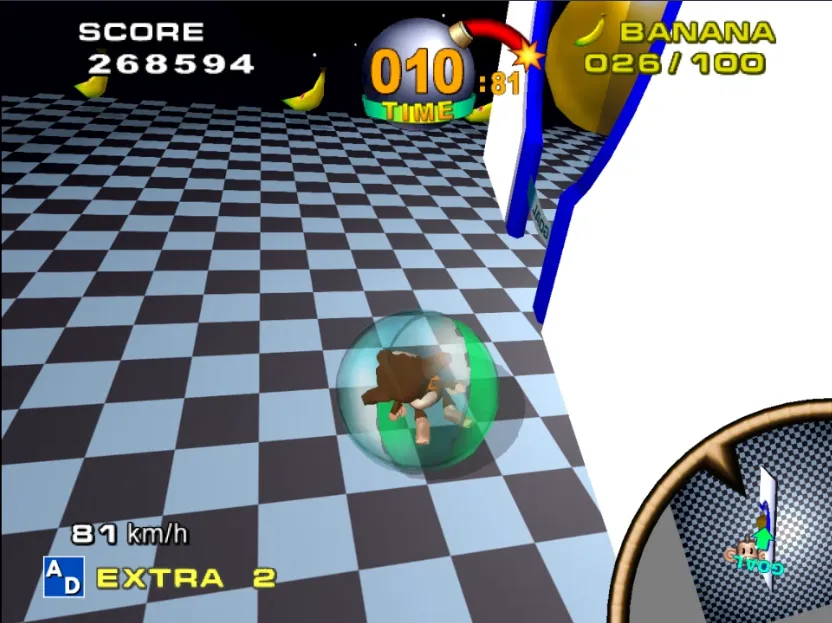
Not pictured: The spinning wall yeeting me out of the small square of the stage, taking away my last life and ending the game as it doesn't let you continue in Extra levels...much to my frustration
Now, Expert is called like that for a very good reason: The first levels are simply harder versions of previous Advanced levels...but the extremely infamous Expert 7 is the hardest incarnation of the level seen at Beginner 10 and Advanced 17 with its thin, curved roads under a time limit (which, even with an increased time of 90 seconds, still causes nightmares to people playing the Banana Mania remake), and from there, a lot of tricky levels, be it by strict gimmicks, being harder versions of levels seen in Advanced, or purely by precision because of extremely thin paths, will keep tormenting you during the attempt to reach and beat Floor 50. It becomes so tough that getting to the 10 Extra levels in Expert only requires you to beat it with one credit instead of doing it deathless, but again, that is easier said than done.
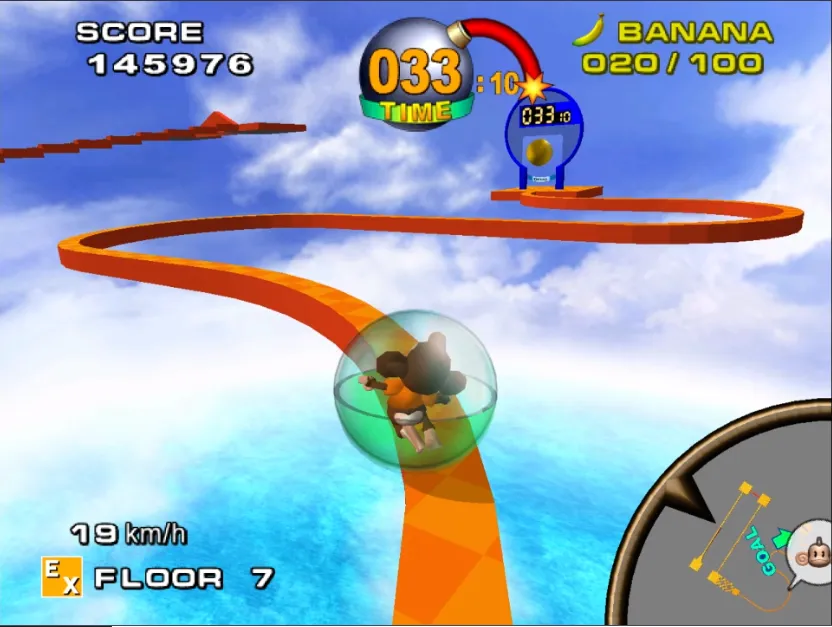
Oh, and if you SOMEHOW survive both Expert and Expert Extra all the way to the end without losing all your lives, you unlock a Master floor. While in the Gamecube port there would be a whopping 10 more levels awaiting you here, in this version you are faced with what would be the 9th floor in that version, having a winding path that turns gets thinner and thinner on almost every turn until the end. If you even make it here at all (let alone complete it), you truly are a Monkey Ball Master (and might become a good surgeon lol).
So what's the veredict on this game? It is pretty fun and challenging, because as I mentioned before, it is virtually the same game as the classic Super Monkey Ball on the Gamecube, except with a simpler presentation, different music, the absence of 9 Master levels at the end of everything (which you might even call a blessing lol), and obviously not having the extra content the Gamecube port has like the splitscreen multiplayer and Party games (since this is an arcade game after all). If anything, it shows how fun this physics-powered idea was even with super simplistic graphics, and it was such a good thing that it made the jump to the purple lunchbox so that people could actually know about the game.
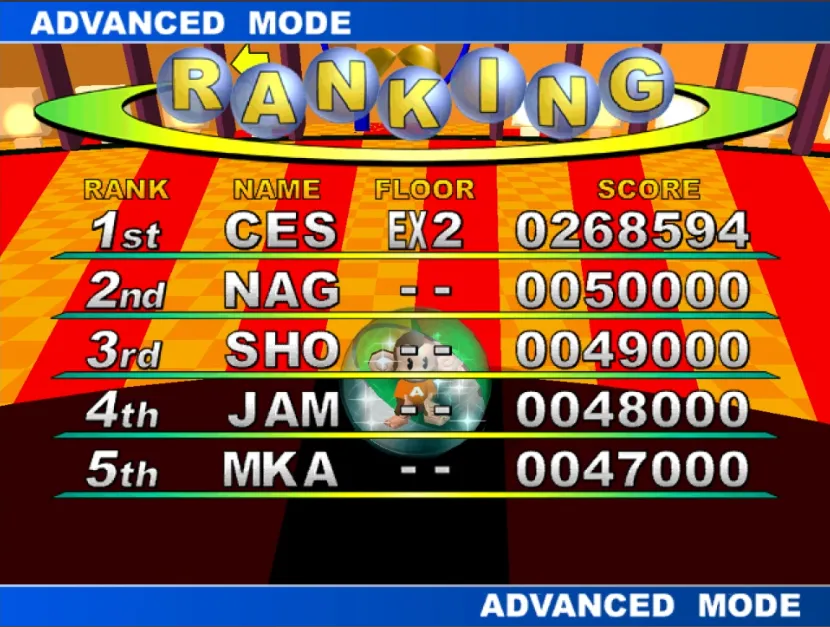

Spanish translation with DeepL. All screenshots were captured by myself.
Español
Es posible que hayas oído hablar de Super Monkey Ball, que ha vivido una montaña rusa de altibajos en su historia, con un comienzo muy fuerte a través de los dos primeros títulos de Gamecube (y el port Deluxe que fusionaba ambos juegos para Xbox y PS2), pero luego teniendo resultados inconsistentes o mixtos, ya que algunos juegos como Super Monkey Ball Jr, Touch and Roll y 3D mantenían la misma jugabilidad sencilla pero todo variaba en función de los controles y el diseño de los niveles (y Adventure, que tenía la misma jugabilidad como modo secundario pero también tenía un modo aventura... que no envejeció bien), mientras que otros como Banana Blitz, Step and Roll y Banana Splitz tenían un enfoque diferente en un truco de control, además de añadir un botón de salto. Aunque Banana Mania, el último remake de los dos primeros juegos, tenía un par de pegas, en general ha sido el mejor de la franquicia después de tanto tiempo, ya que clavó la jugabilidad a la perfección con una capa de pintura moderna.
...pero, ¿de qué estamos hablando hoy? Bueno, Monkey Ball es el primer juego real de la franquicia, lanzado en la placa NAOMI para Arcade basada en Dreamcast, y aunque este juego fue lanzado para ser portado a Dreamcast con un visible lavado de cara, esta versión mejorada acabó siendo trasladada en su lugar a Gamecube, ya que se conocería como Super Monkey Ball. Dicho esto, Monkey Ball en Arcade es prácticamente el mismo juego principal que el primer SMB, con diferencias en la presentación y la ausencia de un conjunto de niveles extremadamente difíciles a los que me referiré más adelante.

La premisa es extremadamente sencilla: Rodar con el stick analógico hasta el final del nivel antes de que se agote el tiempo, aunque en la recreativa original había que jugar con un joystick en forma de plátano (al emular el juego, en su lugar utilicé un mando de Gamecube, que tengo que añadir que es extremadamente adecuado para jugar a este tipo de juegos). Mientras que el juego de Gamecube tenía una cantidad variada de fondos detallados en varios lugares para una cierta cantidad de mundos, esta versión comienza con un fondo de cielo muy simple y un suelo a cuadros, y mientras que algunas etapas tienen fondos como estar en un desierto o en el espacio, estos siguen siendo bastante simples mientras que una vez más utilizan el suelo a cuadros para los niveles.

Tienes tres grupos de niveles: Principiante (10 niveles), Avanzado (30 niveles) y Experto (50 niveles), y en algunos niveles, puedes encontrar metas secretas verdes o rojas en lugar de la habitual meta azul que te permitirán saltar algunos niveles más adelante. Los niveles de Principiante son exactamente tan fáciles como parecen y son perfectos para cualquiera que pruebe el juego por primera vez, ya sea intentando conseguir todos los plátanos o apuntando a la meta tan rápido como pueda, y esencialmente es una campaña tutorial antes de quitarse las ruedas de entrenamiento en el Avanzado. Al completarlo sin caerse ni una sola vez, se desbloquean tres niveles extra, que también son bastante sencillos de superar si te has acostumbrado a los controles.

Dicho esto, los niveles Avanzados exigen un nivel mucho mayor de precisión e incluso de riesgo si quieres apuntar a algunos de los atajos del propio nivel, o a un objetivo Verde/Rojo, y definitivamente necesitarás estar acostumbrado a los controles así como a los reflejos para sobrevivir a ellos. Y lo que es más, hay cinco niveles extra aquí también (tres de ellos son variaciones más difíciles de los vistos en el Principiante)... pero sólo si lo superas todo sin morir ni una sola vez, lo que hace que esos niveles sean aún más angustiosos, ya que esta vez sí que se te plantea un reto, y estos niveles extra pueden ser difíciles de afrontar también cuando perder todas tus vidas en ellos te saca instantáneamente del juego (porque eso es exactamente lo que me pasó a mí con el Extra Avanzado 2; estúpido gol giratorio...)

No aparece en la imagen: El muro giratorio echándome fuera del cuadradito del escenario para el quinto c🤠🤠o, quitándome la última vida y terminando el juego ya que no te deja continuar en los niveles Extra... para mi frustración.
Ahora, Experto se llama así por una muy buena razón: Los primeros niveles son simplemente versiones más duras de los anteriores niveles Avanzados... pero el extremadamente infame Experto 7 es la encarnación más dura del nivel visto en Principiante 10 y Avanzado 17 con sus caminos delgados y curvos bajo un límite de tiempo (que, incluso con un tiempo aumentado de 90 segundos, sigue causando pesadillas a la gente que juega al remake de Banana Mania), y a partir de ahí, un montón de niveles complicados, ya sea por estrictos trucos, por ser versiones más duras de los niveles vistos en Avanzado, o puramente por la precisión debido a los caminos extremadamente delgados, seguirán atormentándote durante el intento de alcanzar y vencer el piso 50. Llega a ser tan difícil que llegar a los 10 niveles extra en Experto sólo requiere que lo superes con un crédito en lugar de hacerlo sin muerte, pero de nuevo, es más fácil decirlo que hacerlo.

Ah, y si de alguna manera sobrevives tanto a Experto como a Experto Extra hasta el final sin perder todas tus vidas, desbloqueas un piso Maestro. Mientras que en la versión de Gamecube te esperaban la friolera de 10 niveles más, en esta versión te enfrentas a lo que sería la 9ª planta en esa versión, con un camino sinuoso que se va haciendo más y más fino en casi cada vuelta hasta el final. Si consigues llegar hasta aquí (por no hablar de completarlo), serás un verdadero maestro de Monkey Ball (y puede que te conviertas en un buen cirujano lol).
¿Cuál es el veredicto de este juego? Es bastante divertido y desafiante, ya que, como he mencionado antes, es prácticamente el mismo juego que el clásico Super Monkey Ball de Gamecube, salvo que tiene una presentación más sencilla, una música diferente, la ausencia de 9 niveles de Maestro al final de todo (lo que incluso podría llamarse una bendición lol) y, obviamente, no tiene el contenido extra que tiene el port de Gamecube, como el multijugador a pantalla partida y las partidas de Party (ya que, al fin y al cabo, este es un juego arcade). En todo caso, demuestra lo divertida que era esta idea basada en la física, incluso con unos gráficos súper simplistas, y fue un acierto que diera el salto a la lonchera púrpura para que la gente pudiera conocer el juego.


Traducción al español hecha con DeepL. Todas las fotos capturadas por mí.
